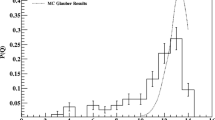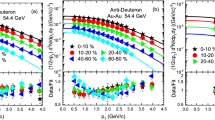Summary
A study of fast baryons emitted from 12 150 K− meson interactions at rest in emulsion has been made in order to determine the nature and extent of K− meson-multinucleon capture processes. Fast Σ hyperons are produced in at least 9 per cent of all interactions while direct fast Λ0 hyperon production is indicated by the presence of 3 protons with energies exceeding 200 MeV. An upper limit of 30% is obtained for multinucleon processes (not producing π mesons) from consideration of π meson emission. The energy spectra for fast Σ hyperons and fast protons are given and mass determinations on a sample of so-called fast protons have revealed about 10% of deuterons and tritons. The suggestion in K− European Collaboration Part II of an apparent infrequency of the reaction K−+n+n→Σ−+n has been confirmed and anα-particle model of K− meson multinucleon interaction has been put forward to explain both this and the emission of deuterons and tritons.
Riassunto
Allo scopo di determinare la frequenza e le caratteristiche del processo di cattura « a più nucleoni » dei mesoni K−, sono stati studiate la frequenza e la distribuzione energetica dei barioni « veloci » (energia cinetica ⩾60 MeV per iperoni Σ) emessi da un gruppo di 12 150 interazioni di mesoni K− a riposo. Gli iperoni Σ carichi « veloci » sono emessi con la frequenza del (2.3±0.2)%, i negativi essendo due volte più numerosi dei positivi. La frequenza di produzione di iperoni Σ carichi e neutri nell’ipotesi di processi « a due nucleoni » può essere valutata del 9%: questo è anche un limite inferiore per la frequenza dei processi « a più nucleoni » (nei quali non vengano prodotti mesoni π). Un limite superiore si ottiene dal rapporto π±/K−, e risulta ∼30%. La presenza di protoni (non accompagnati da iperframmenti, mesoni π± o iperoni Σ±) con energia maggiore di 200 MeV indica la possibilità di produzione diretta di iperoni Λ0 in processi « a più nucleoni ». Si osserva infine che gli iperoni Σ− « veloci » sono accompagnati in due terzi dei casi da un protone di più di 30 MeV, ed è raro che siano emessi senza essere associati ad altre particelle cariche, mentre gli iperoni Σ± « veloci » sono raramente accompagnati da protoni veloci, mentre in poco meno del 40% dei casi sono l’unica particella carica emessa. Questo risultato può indicare una intrinseca rarità della reazione K−+n+n→Σ−+n, ma può essere interpretato anche come conseguenza dell’interazione del mesone K− con un gruppo di nucleoni, di cui almeno uno è un protone, e in particolare con una particellaα. Il fatto che il 10% circa dei barioni veloci sia costituito da deutoni e tritoni è in accordo con questo modello.
Similar content being viewed by others
References
M. C. Amerighi, M. J. Beniston, A. Bonetti, D. H. Davis, M. Di Corato, C. C. Dilworth, D. Ferreira, E. Frota-Pessoa, W. B. Lasich, N. N. Raina, M. René J. Sacton andA. E. Sichirollo:Nuovo Cimento,12, 91 (1959).
K − European Collaboration, Part II:Nuovo Cimento,14, 315 (1959).
107 events quoted byM. Nikolić, Y. Eisenberg, W. Koch, M. Schneeberger, andH. Winzeler:Helv. Phys. Acta,33, 237 (1960) and 21 events found in this stack.
D. A. Glaser:Kiev Conference Report (1959).
K − European Collaboration, Part III:Nuovo Cimento,15, 873 (1960).
D. H. Davis, B. D. Jones andJ. Zakrzewski:Nuovo Cimento,14, 265 (1959).
See reference (2), and also report byE. H. S. Burhop to the Kiev Conference, 1959.
D. H. Wilkinson:Phil. Mag.,4, 215 (1959).
Helium Bubble Chamber, K− Collaboration Group, Rochester Conference, 1960.
L. W. Alvarez:Kiev Conference Report, (1959).
The Berne group, (see footnote, page 4), from a similar argument, quote the frequency of multi-nucleon processes to be (37±5)%.U. Kundt, K. Lanius andK. Lewin (Nuovo Cimento,14, 943 (1959)) find from their data ∼20%, but they use larger absorption probabilities for the π mesons.
Author information
Authors and Affiliations
Rights and permissions
About this article
Cite this article
Jones, B.D., Sanjeevaiah, B., Zakrzewski, J. et al. On the observation of fast Σ-hyperons emitted from the interactions of K−-mesons with emulsion nuclei. Nuovo Cim 19, 1077–1089 (1961). https://doi.org/10.1007/BF02731384
Received:
Published:
Issue Date:
DOI: https://doi.org/10.1007/BF02731384




